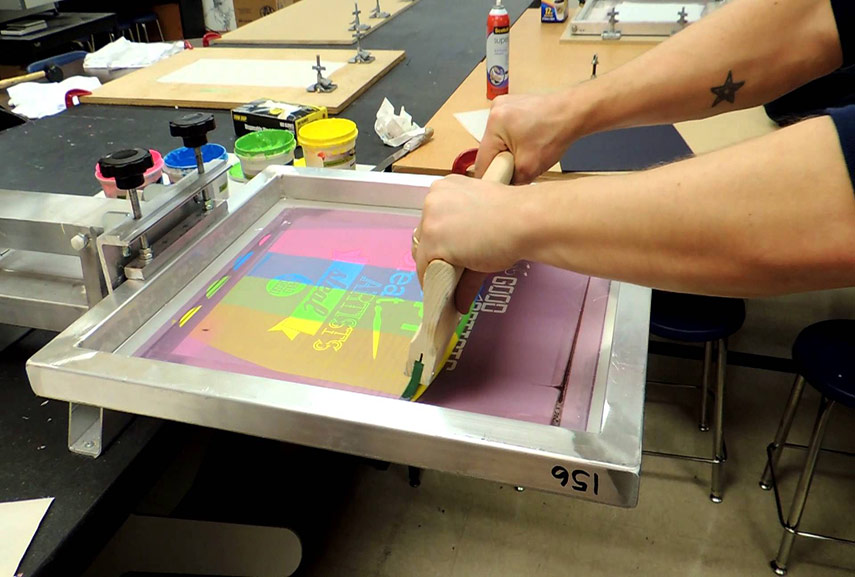ChatGPT said: 10:9 Design Abilene: the best team for custom apparel and branding
The Necessary Overview to Comprehending Screen Printing and Its Versatile Uses
Screen printing has a rich history that dates back to old times, evolving right into an innovative strategy made use of throughout different markets today. This guide explores the intricacies of the screen printing process, outlining its applications in home, fashion, and advertising decoration - 10:9 Design Screen Printing Texas. Understanding these principles can open imaginative capacity for both commercial and imaginative jobs. The complying with sections will expose vital tips and strategies to improve one's screen printing endeavors
The Background of Screen Printing
Screen printing has roots that trace back centuries, its development mirrors the artistic and technical innovations of various cultures. Originating in ancient China, the strategy was initially utilized for embellishing textiles and later spread to Japan, where it became important to Ukiyo-e woodblock printing. The approach shifted to Europe in the 18th century, where it gained appeal among artisans and industrial printers. The invention of photo solution in the 20th century revolutionized screen printing, permitting more complex designs and greater performance. Musicians like Andy Warhol even more thrust its popularity, utilizing the medium to create famous jobs that combined commercialism and art. By the late 20th century, screen printing had developed itself as a functional strategy, employed in vogue, advertising and marketing, and art. Today, it continues to develop, integrating electronic modern technology and increasing its applications throughout various industries.
The Screen Printing Process Explained
Screen printing transforms creative visions into concrete styles with a collection of specific actions. Originally, a photo is created and afterwards transferred onto a screen, usually made from great mesh material stretched over a framework. A light-sensitive emulsion is used to the screen, which is revealed to light, setting in locations not covered by the photo. After washing out the unhardened emulsion, a stencil is created.
Next off, the screen is placed over the substrate, whether it be textile, paper, or one more material. Ink is then pressed via the open areas of the stencil using a squeegee, depositing the design onto the substrate listed below. This process can be repeated for numerous colors, calling for separate screens for each and every hue. Lastly, the printed item is healed using warmth to guarantee the ink sticks appropriately, resulting in a long lasting, vibrant style ready for use.
Kinds of Screen Printing Techniques

Furthermore, specialty methods, such as discharge screen printing, remove color from the fabric to develop softer prints, while foil screen printing applies metal foil to achieve a shiny finish (10:9 Design contact). Each method supplies distinct attributes, satisfying numerous creative requirements and manufacturing ranges, inevitably increasing the possibilities within the screen printing domain name
Applications of Screen Printing in Different Industries

In addition, the signage and marketing sectors use screen printing for developing attractive display screens and banners. This approach enables vibrant colors and intricate designs that catch attention. In electronics, screen printing is utilized for using conductive inks to circuit card, essential for component links. The home design industry embraces screen printing to generate distinctive designs on fabrics and wall art. On the whole, screen printing works as a vital tool across diverse fields, improving items with individualized and aesthetically appealing graphics.
Tips for Successful Screen Printing Projects
While taking on a screen printing job, careful interest to detail can considerably improve the final end result. First, selecting high-grade materials is necessary; this consists of the screen, inks, and substrates. Making use of suitable mesh counts can affect ink deposition and detail resolution. Prep work is equally crucial; complete cleaning of screens and proper exposure times guarantee crisp prints.
Next, precise registration is important for multi-color prints. Utilizing placement devices can aid attain precise layering. Furthermore, screening prints on scrap materials prior to manufacturing assists recognize prospective concerns without wasting resources.

Regularly Asked Inquiries
What Materials Are Finest for Screen Printing on Textile?
Cotton and polyester blends are ideal for screen printing on fabric as a result of their sturdiness and ink absorption. Furthermore, specialty materials like silk or canvas can create special structures and surfaces, improving the overall style top quality.
Just how Do I Tidy and Maintain Screen Printing Equipment?
To maintain and clean up screen printing sign board printing equipment, one should routinely wash displays with proper solvents, check squeegees for wear, lube moving parts, and shop all products in a dry, dust-free atmosphere to prolong their life expectancy.
What Are the Ecological Impacts of Screen Printing?
Screen printing can have substantial environmental effects, consisting of chemical waste from inks and solvents, water usage throughout cleansing processes, and power consumption. Sustainable methods and eco-friendly materials are vital for decreasing these negative impacts.
Can Screen Printing Be Done in the house Properly?
Screen printing can be successfully done at home with the appropriate products and techniques. Enthusiasts can produce high quality prints, though success depends on their skill degree, devices, and understanding of the process entailed.
What Are the Prices Connected With Starting a Screen Printing Business?

Starting a screen printing business involves expenses for tools, products, and office. Preliminary costs normally vary from a few hundred to numerous thousand dollars, relying on the range, top quality of machinery, and wanted manufacturing capacity.
Screen printing has an abundant background that dates back to old times, evolving into a sophisticated strategy made use of across various sectors today. One more strategy, rotating screen printing, utilizes round screens, assisting in continuous printing on fabric rolls, thereby enhancing efficiency for massive manufacturings. Additionally, specialized strategies, such as discharge screen printing, eliminate dye from the textile to produce softer prints, while foil screen printing uses metallic foil to attain a shiny surface. In the fashion industry, screen printing is extensively made use of to develop vivid styles on apparel, enabling brands to display their distinct styles. Cotton and polyester blends are perfect for screen printing on material due to their sturdiness and ink absorption.